指定production组安装httpd
---
- hosts: production
tasks:
- name: install httpd
yum:
name: httpd
state: present
- name: start httpd
service:
name: httpd
state: started
运行文件
ansible-playbook playbook.yaml
ansible-playbook playbook.yaml --syntax-check #检查语法
ansible-playbook playbook.yaml --list-task # 检测任务
ansible-playbook playbook.yaml --list-hosts# 检查生效主机
ansible-playbook playbook.yaml --start-at-task= # 指定开始的task位置
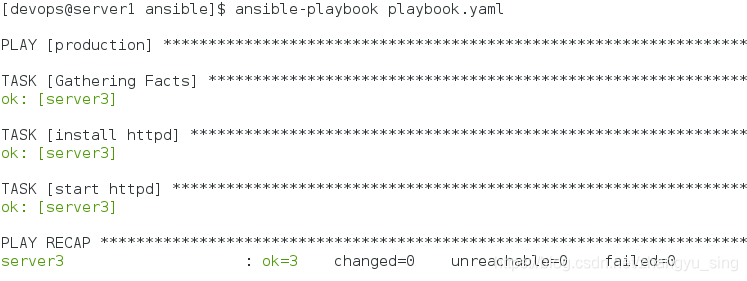
vim配置两个tab
set smartindent
set tabstop=2
set shiftwidth=2
set expandtab
set softtabstop=2

httpd安装优化
---
- hosts: production
tasks:
- name: install httpd
yum:
name: httpd
state: present
- name: conf file
copy:
src: files/httpd.conf
dest: /etc/httpd/conf/httpd.conf
owner: root
group: root
mode: 644
notify: restart httpd # 触发器的使用
- name: start httpd
service:
name: httpd
state: started
handlers: #触发器
- name: restart httpd
service:
name: httpd
state: restarted
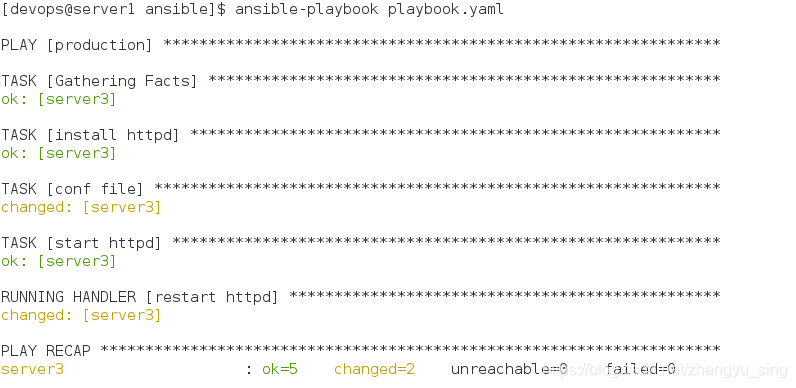
httpd配置防火墙以及测试
---
- hosts: production
tasks:
- name: install httpd
yum:
name: httpd
state: present
- name: copy index.html
copy:
src: files/index.html
dest: /var/www/html/index.html
- name: configure file
copy:
src: files/httpd.conf
dest: /etc/httpd/conf/httpd.conf
owner: root
group: root
mode: 644
notify: restart httpd
- name: start httpd and firewalld
service:
name: "{{ item }}"
state: started
loop:
- firewalld
- httpd
- name: configure firewalld
firewalld:
service: http
permanent: yes
immediate: yes
state: enabled
handlers:
- name: restart httpd
service:
name: httpd
state: restarted
- hosts: localhost
become: no
tasks:
- name: test httpd
uri:
url: http://172.25.33.3
status_code: 200
变量的使用方式
yaml文件中添加,以及inventory文件中设置
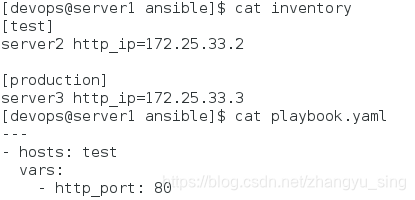
---
- hosts: test
vars:
- http_port: 80
tasks:
- name: install httpd
yum:
name: httpd
state: present
- name: copy index.html
copy:
src: files/index.html
dest: /var/www/html/index.html
- name: configure file
template:
src: template/httpd.conf.j2
dest: /etc/httpd/conf/httpd.conf
owner: root
group: root
mode: 644
notify: restart httpd
- name: start httpd and firewalld
service:
name: "{{ item }}"
state: started
loop:
- firewalld
- httpd
- name: configure firewalld
firewalld:
service: http
permanent: yes
immediate: yes
state: enabled
handlers:
- name: restart httpd
service:
name: httpd
state: restarted
- hosts: localhost
become: no
tasks:
- name: test httpd
uri:
url: http://172.25.33.3
status_code: 200
运行结果

返回变量的值,并写入文件
cat file.yaml
---
- hosts: all
tasks:
- name: create file
template:
src: template/file.j2
dest: /tmp/
cat template/file.j2
主机名: {{ ansible_facts['hostname'] }}
主机IP: {{ ansible_facts['default_ipv4']['address'] }}
主机DNS: {{ ansible_facts['dns']['nameservers'][0] }}
boot分区: {{ ansible_facts['devices']['sda']['partitions']['sda1']['size'] }}
内核: {{ ansible_facts['kernel'] }}
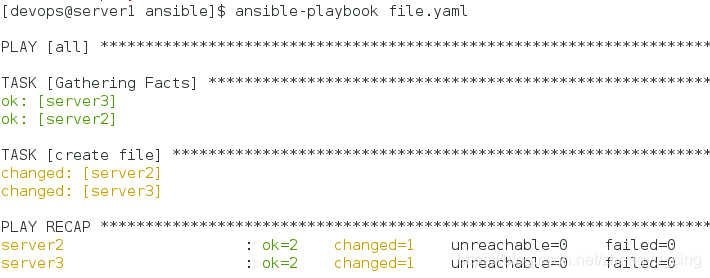
server2主机查看结果
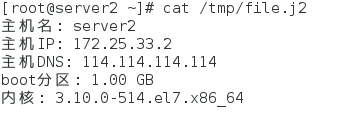
配置haproxy负载均衡
---
- hosts: test:production
vars:
- http_port: 80
tasks:
- name: install httpd
yum:
name: httpd
state: present
- name: copy index.html
copy:
content: "{{ ansible_facts['hostname'] }}"
dest: /var/www/html/index.html
- name: configure file
template:
src: template/httpd.conf.j2
dest: /etc/httpd/conf/httpd.conf
owner: root
group: root
mode: 644
notify: restart httpd
- name: start httpd and firewalld
service:
name: "{{ item }}"
state: started
loop:
- firewalld
- httpd
- name: configure firewalld
firewalld:
service: http
permanent: yes
immediate: yes
state: enabled
handlers:
- name: restart httpd
service:
name: httpd
state: restarted
- hosts: localhost
tasks:
- name: test httpd
uri:
url: http://172.25.33.3
status_code: 200
- name: install haproxy
yum:
name: haproxy
state: present
- name: start haproxy
service:
name: haproxy
state: started
- name: configure haproxy
copy:
src: template/haproxy.cfg.j2
dest: /etc/haproxy/haproxy.cfg
notify: restart haproxy
handlers:
- name: restart haproxy
service:
name: haproxy
state: restarted
配置文件haproxy.cfg内容
#---------------------------------------------------------------------
# Example configuration for a possible web application. See the
# full configuration options online.
#
# http://haproxy.1wt.eu/download/1.4/doc/configuration.txt
#
#---------------------------------------------------------------------
#---------------------------------------------------------------------
# Global settings
#---------------------------------------------------------------------
global
# to have these messages end up in /var/log/haproxy.log you will
# need to:
#
# 1) configure syslog to accept network log events. This is done
# by adding the '-r' option to the SYSLOGD_OPTIONS in
# /etc/sysconfig/syslog
#
# 2) configure local2 events to go to the /var/log/haproxy.log
# file. A line like the following can be added to
# /etc/sysconfig/syslog
#
# local2.* /var/log/haproxy.log
#
log 127.0.0.1 local2
chroot /var/lib/haproxy
pidfile /var/run/haproxy.pid
maxconn 4000
user haproxy
group haproxy
daemon
# turn on stats unix socket
stats socket /var/lib/haproxy/stats
#---------------------------------------------------------------------
# common defaults that all the 'listen' and 'backend' sections will
# use if not designated in their block
#---------------------------------------------------------------------
defaults
mode http
log global
option httplog
option dontlognull
option http-server-close
option forwardfor except 127.0.0.0/8
option redispatch
retries 3
timeout http-request 10s
timeout queue 1m
timeout connect 10s
timeout client 1m
timeout server 1m
timeout http-keep-alive 10s
timeout check 10s
maxconn 3000
stats uri /status
#---------------------------------------------------------------------
# main frontend which proxys to the backends
#---------------------------------------------------------------------
frontend main *:80
acl url_static path_beg -i /static /images /javascript /stylesheets
acl url_static path_end -i .jpg .gif .png .css .js
default_backend app
#---------------------------------------------------------------------
# static backend for serving up images, stylesheets and such
#---------------------------------------------------------------------
#---------------------------------------------------------------------
backend app
balance roundrobin
server app1 172.25.33.2:80 check
server app2 172.25.33.3:80 check
测试

修改haproxy文件设置负载均衡自动检测添加节点
backend app
balance roundrobin
{% for host in groups['webserver'] %}
server {{ hostvars[host]['ansible_facts']['hostname'] }} {{ hostvars[host]['ansible_facts']['eth0']['ipv4']['address'] }}:80 check
{% endfor %}






 本文详细介绍如何使用Ansible进行自动化部署与配置管理,包括httpd的安装与优化,防火墙配置,以及通过模板和变量实现动态配置。同时,演示了如何配置负载均衡并测试服务可用性。
本文详细介绍如何使用Ansible进行自动化部署与配置管理,包括httpd的安装与优化,防火墙配置,以及通过模板和变量实现动态配置。同时,演示了如何配置负载均衡并测试服务可用性。
















 1万+
1万+

 被折叠的 条评论
为什么被折叠?
被折叠的 条评论
为什么被折叠?








